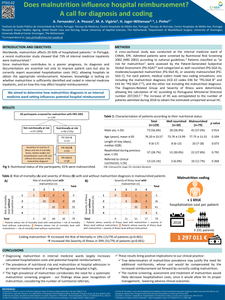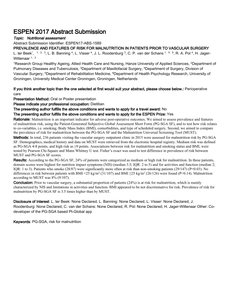In 2010, the definition of cachexia was jointly developed by the European Society for Clinical Nutrition and Metabolism (ESPEN) Special Interest Groups (SIG) "Cachexia-anorexia in chronic wasting diseases" and "Nutrition in geriatrics". Cachexia was considered as a synonym of disease-related malnutrition (DRM) with inflammation by the ESPEN guidelines on definitions and terminology of clinical nutrition. Starting from these concepts and taking into account the available evidence the SIG "Cachexia-anorexia in chronic wasting diseases" conducted several meetings throughout 2020-2022 to discuss the similarities and differences between cachexia and DRM, the role of inflammation in DRM, and how it can be assessed. Moreover, in line with the Global Leadership Initiative on Malnutrition (GLIM) framework, in the future the SIG proposes to develop a prediction score to quantify the individual and combined effect(s) of multiple muscle and fat catabolic mechanisms, reduced food intake or assimilation and inflammation, which variably contribute to the cachectic/malnourished phenotype. This DRM/cachexia risk prediction score could consider the factors related to the direct mechanisms of muscle catabolism separately from those related to the reduction of nutrient intake and assimilation. Novel perspectives in the field of DRM with inflammation and cachexia were identified and described in the report.
DOCUMENT
MULTIFILE

Objectives: Malnutrition is associated with a twofold higher risk of dying in patients with tuberculosis (TB) and considered an important potentially reversible risk factor for failure of TB treatment. The construct of malnutrition has three domains: intake or uptake of nutrition; body composition and physical and cognitive function. The objectives of this systematic review are to identify malnutrition assessment methods, and to quantify how malnutrition assessment methods capture the international consensus definition for malnutrition, in patients with TB.Design: Different assessment methods were identified. We determined the extent of capturing of the three domains of malnutrition, that is, intake or uptake of nutrition, body composition and physical and cognitive function.Results: Seventeen malnutrition assessment methods were identified in 69 included studies. In 53/69 (77%) of studies, body mass index was used as the only malnutrition assessment method. Three out of 69 studies (4%) used a method that captured all three domains of malnutrition.Conclusions: Our study focused on published articles. Implementation of new criteria takes time, which may take longer than the period covered by this review. Most patients with TB are assessed for only one aspect of the conceptual definition of malnutrition. The use of international consensus criteria is recommended to establish uniform diagnostics and treatment of malnutrition.
LINK
The aim of this systematic review was to examine the association between malnutrition and oral health in older people (≥ 60 years of age). A comprehensive systematic literature search was performed in four databases (PubMed, CINAHL, Dentistry and Oral Sciences Source, and Embase) for literature from January 2000 to May 2020. Both observational and intervention studies were screened for eligibility. Two reviewers independently screened the search results to identify potential eligible studies, and assessed the methodological quality of the full-text studies. A total of 3240 potential studies were identified. After judgement for relevance, 10 studies (cross-sectional (n = 9), prospective cohort (n = 1)) met the inclusion criteria. Three studies described malnourished participants as having fewer teeth, or functional (tooth) units (FTUs), compared to well-nourished participants. Four studies reported soft tissue problems in malnourished participants, including red tongue with blisters, and dry or cracked lips. Subjective oral health was the topic in six studies, with poorer oral health and negative self-perception of oral health in malnourished elderly participants. There are associations between (at risk of) malnutrition and oral health in older people, categorized in hard and soft tissue conditions of the mouth, and subjective oral health. Future research should be focused on longitudinal cohort studies with proper determination of malnutrition and oral health assessments, in order to evaluate the actual association between malnutrition and oral health in older people.
DOCUMENT

Background: Disease-related malnutrition is a significant problem in hospitalized patients, with high prevalence rates depending on the studied population. Internal Medicine wards are the backbone of the hospital setting. However, prevalence and determinants of malnutrition in these patients remain unclear. We aimed to determine the prevalence of malnutrition in Internal Medicine wards and to identify and characterize malnourished patients. Methods: A cross-sectional observational multicentre study was performed in Internal Medicine wards of 24 Portuguese hospitals during 2017. Demographics, hospital admissions during the previous year, type of admission, primary diagnosis, Charlson comorbidity index, and education level were registered. Malnutrition at admission was assessed using Patient-Generated Subjective Global Assessment (PG-SGA). Demographic characteristics were compared between well-nourished and malnourished patients. Logistic regression analysis was used to identify determinants of malnutrition. Results: 729 participants were included (mean age 74 years, 51% male). Main reason for admission was respiratory disease (32%). Mean Charlson comorbidity index was 5.8 ± 2.8. Prevalence of malnutrition was 73% (56% moderate/suspected malnutrition and 17% severe malnutrition), and 54% had a critical need for multidisciplinary intervention (PG-SGA score ≥9). No education (odds ratio [OR] 1.88, 95% confidence interval [CI]: 1.16–3.04), hospital admissions during previous year (OR 1.53, 95%CI: 1.05–2.26), and multiple comorbidities (OR 1.22, 95%CI: 1.14–1.32) significantly increased the odds of being malnourished. Conclusions: Prevalence of malnutrition in the Internal Medicine population is very high, with the majority of patients having critical need for multidisciplinary intervention. Low education level, admissions during previous year, and multiple comorbidities increase the odds of being malnourished.
DOCUMENT
As the population ages, the risk of becoming malnourished increases. Research has shown that poor oral health can be a risk factor for malnutrition in institutionalized elderly. However, it remains unclear whether oral health problems, edentulousness and health-related quality of life also pose a risk for malnutrition in community-dwelling older adults. In this cross-sectional observational study, 1325 community-living elderly (≥75 years) were asked to complete questionnaires regarding nutritional status, oral status (edentulous, remaining teeth, or implant-supported overdentures), oral health problems, health-related quality of life (HRQoL), frailty, activities of daily living (ADL) and complexity of care needs. Univariate and multivariate logistic regression analyses were performed with nutritional status as dependent variable. Of the respondents, 51% (n = 521) were edentulous, 38.8% (n = 397) had remaining teeth and 10.2% (n = 104) had an implant-supported overdenture. Elderly with complex care needs were malnourished most frequently, followed by frail and robust elderly (10%, 4.5% and 2.9%, respectively). Malnourished elderly reported more frequent problems with chewing and speech when compared with well-nourished elderly (univariate analysis). However, multivariate analysis did not show an association between malnutrition and oral health problems and edentulousness, although HRQoL was associated with malnutrition (odds ratio (OR) 0.972, confidence interval (CI) 0.951–0.955). Based on the results of this cross-sectional study, it can be concluded that poor HRQoL is significantly associated with malnutrition; however, edentulousness and oral health problems are not.
DOCUMENT

DOCUMENT

Malnutrition is a frequent problem in patients with head and neck cancer. Prevention or timely treatment of malnutrition isof great importance because deteriorated nutritional status can have a negative effect on clinical outcome in head andneck cancer patients.Malnutrition is a multidimensional problem, in which a nutritional disbalance causes loss of weight and muscle mass, eitheror not accompanied by inflammatory activity, resulting in functional decline.Thus far, little is known about the role of physical activity in both the development and treatment of malnutrition in cancerpatients. Although positive effects of exercise on fatigue and quality of life have been reported, the relationship betweenphysical activity and prevention and treatment of malnutrition needs to be further elucidated.In this presentation, current insights and hypotheses on the relationship between physical activity and nutritional status inpatients with cancer will be discussed.
DOCUMENT

DOCUMENT
